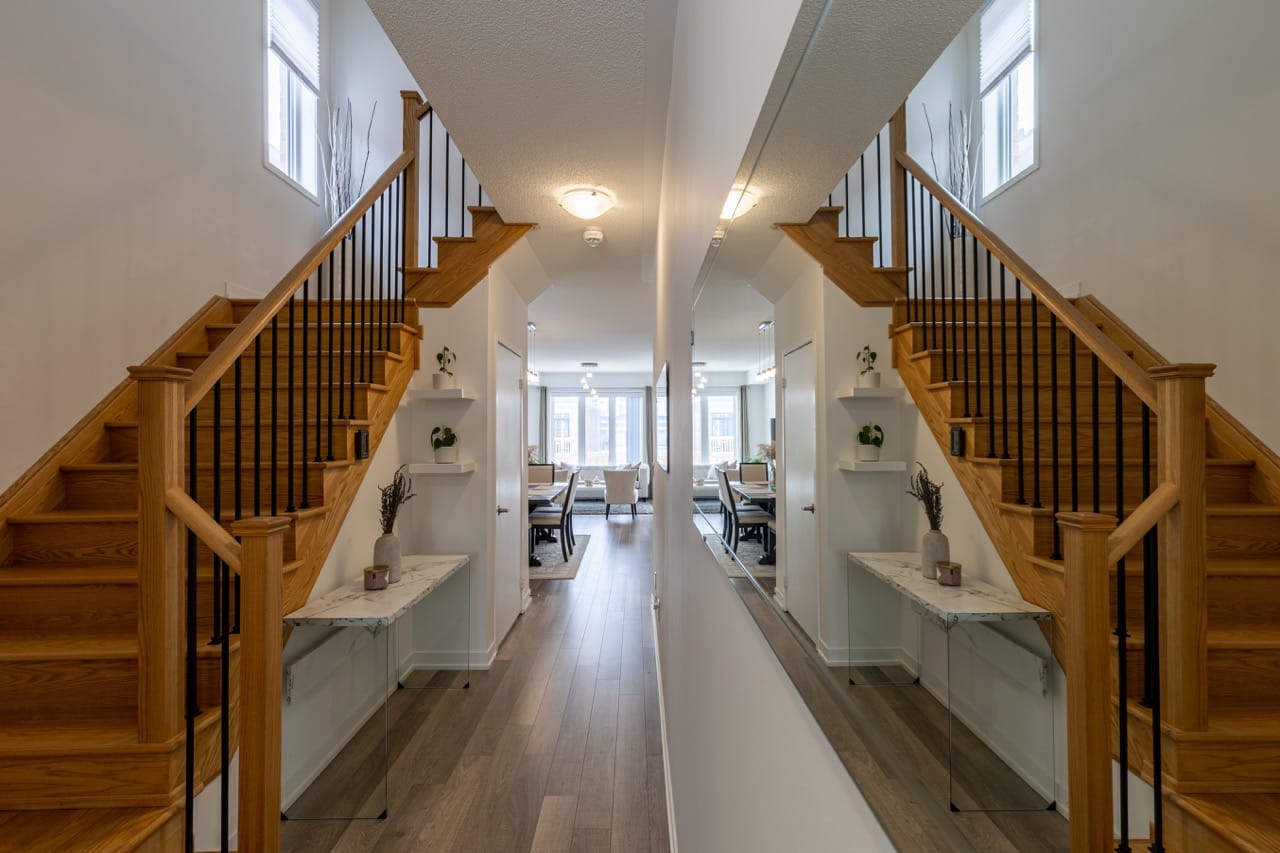Lighting plays a crucial role in enhancing the ambiance and functionality of any space, and this is especially true for hallways and stairwells. These areas often serve as transitional zones within a home or building, connecting different rooms or levels. Therefore, it is imperative to ensure they are adequately illuminated to promote safety, comfort, and visual appeal.
The Importance of Proper Lighting in Hallways and Stairwells
In hallways and stairwells, proper lighting goes beyond just illuminating the path; it contributes to creating a welcoming atmosphere while ensuring safe navigation. Without adequate lighting, these areas can become potential hazards by increasing the risk of accidents such as slips, trips, or falls.
Insufficient light can lead to obscured obstacles or create shadows that distort depth perception—both detrimental factors when traversing stairs or moving through narrow passages. Besides safety concerns, appropriate lighting also affects the overall experience within these spaces.
Well-lit hallways offer a sense of spaciousness and guide occupants with ease from one area to another. By providing sufficient illumination levels that complement architectural features or decorative elements along the way, an inviting ambiance can be achieved.
The Advantages of LED Lights for Hallways and Stairwells
When it comes to choosing lighting solutions for hallways and stairwells, LED lights stand out as an exceptional choice due to their numerous advantages over traditional lighting technologies. Energy Efficiency: LED lights are renowned for their high energy efficiency compared to incandescent bulbs or fluorescent tubes.
They consume significantly less electricity while producing an equivalent amount of light output. This not only reduces energy bills but also helps decrease environmental impact by lowering carbon emissions.
Durability: LED lights have a longer lifespan than traditional lighting options, making them ideal for areas where frequent replacement can be inconvenient. With an average lifespan of 50,000 to 100,000 hours, LEDs outlast incandescent bulbs by up to 20 times and fluorescent lights by up to 10 times.
Design Flexibility: LED lights offer a wide range of design options suitable for hallways and stairwells. Whether it is recessed lighting that seamlessly integrates into the ceiling or wall sconces that add a touch of elegance, LEDs provide versatility in terms of form factor and aesthetics.
Instantaneous Lighting: Unlike traditional lighting technologies that may take some time to reach their full brightness, LED lights illuminate instantly without any warm-up period. This characteristic is particularly advantageous in hallways and stairwells where immediate visibility is essential for safety reasons.
By capitalizing on the energy efficiency, durability, design flexibility, and instantaneous illumination provided by LED lights, homeowners and building managers can create well-lit hallways and stairwells that enhance both safety and aesthetics. In the following sections, we will delve deeper into understanding LED technology and explore specific factors to consider when selecting LED lights for these areas.

Understanding LED Lights
The Science of LED Technology
LED stands for Light Emitting Diode, and it revolutionized the lighting industry with its innovative design and energy efficiency. Unlike traditional incandescent or fluorescent bulbs, which rely on heat or gas to produce light, LEDs work by passing an electrical current through a semiconductor material. This process emits photons, creating visible light.
The semiconductor is typically made of a compound like gallium arsenide or gallium nitride. LEDs are renowned for their longevity due to their solid-state construction.
They lack filaments that burn out over time, making them incredibly durable and resistant to shocks and vibrations. Additionally, LEDs boast an impressive lifespan of up to 50,000 hours or more compared to incandescent bulbs that last only around 1,000 hours.
The Benefits of LED Lights in Hallways and Stairwells
The use of LED lights in hallways and stairwells offers numerous advantages beyond their long lifespan. One key benefit is their exceptional energy efficiency. LEDs consume significantly less electricity compared to traditional lighting options, translating into substantial energy savings over time.
This not only reduces your carbon footprint but also contributes to lower utility bills. LED lights are also highly directional in nature, allowing for precise beam control.
In hallways and stairwells where focused illumination is crucial for safety reasons, this feature ensures that light is directed exactly where it’s needed most – on the floor or steps – minimizing glare and increasing visibility in these critical areas. Moreover, LEDs emit very little heat compared to incandescent bulbs or halogens, reducing the risk of accidental burns when touched or bumped against by passersby.
This characteristic makes them particularly suitable for narrow hallways where space constraints exist. Additionally, LED lights do not contain harmful substances like mercury commonly found in fluorescent lamps.
This makes them more environmentally friendly and easier to dispose of at the end of their lifespan. Considering these advantages, it becomes evident why LED lights are a preferred choice for hallways and stairwells, where safety, energy efficiency, and long-lasting performance take precedence.
Factors to Consider When Choosing LED Lights for Hallways and Stairwells
Brightness and Lumens
When selecting LED lights for your hallways and stairwells, it is essential to consider the brightness they emit, as this directly impacts safety. The brightness of LED lights is measured in lumens, which quantifies the amount of light emitted.
The size of your hallway should dictate the recommended lumens to ensure sufficient illumination. For narrow hallways or stairwells, around 300-500 lumens per linear foot is generally recommended.
In larger areas, such as spacious hallways or grand staircases, you may want to opt for higher output options ranging from 500-800 lumens. Adequate brightness in these areas contributes significantly to safety by ensuring clear visibility and minimizing the risk of accidents.
Insufficient light can create shadows or dark spots that compromise navigation and increase the likelihood of tripping or other mishaps. By selecting LED lights with appropriate lumen output for your hallway or stairwell size, you can enhance visibility and create a well-lit environment that promotes safe movement throughout these spaces.
Color Temperature
Understanding the concept of color temperature is crucial when choosing LED lights for hallways and stairwells. Color temperature refers to the perceived warmth or coolness of light emitted by a bulb, measured on the Kelvin (K) scale. For these areas, it is advisable to aim for a color temperature on the cooler side, typically between 4000K-5000K.
Cooler color temperatures mimic natural daylight and provide an energizing effect that stimulates alertness in occupants traversing hallways and stairs. This crisp white light enhances visual acuity, making obstacles more apparent while creating a sense of spaciousness in these confined spaces.
It’s important to note that warm color temperatures (2700K-3000K) can create a cozy and inviting ambiance in living spaces but might not be suitable for hallways and stairwells, where functionality and security are paramount. Cooler color temperatures offer a balance between aesthetics and practicality, promoting safety while maintaining a well-illuminated atmosphere.
Energy Efficiency
One of the most significant advantages of LED lights is their exceptional energy efficiency compared to traditional lighting options like incandescent or fluorescent bulbs. LEDs consume significantly less electricity to produce the same amount of light as their counterparts, resulting in substantial energy savings.
By choosing LED lights for hallways and stairwells, you can reduce your energy consumption by up to 80% compared to traditional lighting systems. This translates not only into immediate cost savings on your electricity bill but also long-term financial benefits due to the extended lifespan of LEDs.
LED lights generally last much longer than conventional bulbs, minimizing replacement frequency and associated costs. Moreover, the reduced energy consumption of LEDs contributes to environmental sustainability by lowering carbon emissions that result from conventional electricity generation.
By selecting energy-efficient LED lights for your hallways and stairwells, you align yourself with eco-friendly practices while enjoying the economic advantages they bring. When considering LED lights for your hallways and stairwells, it is essential to take into account factors such as brightness (measured in lumens), color temperature (Kelvin scale), and energy efficiency.
Choosing appropriate brightness levels tailored to your hallway or staircase size ensures adequate illumination for safe movement. Opting for cooler color temperatures enhances visibility while striking a balance between utility and aesthetics.
Embracing the impressive energy efficiency of LEDs not only saves costs but also supports sustainable practices. By carefully considering these factors in your selection process, you can create well-lit environments that prioritize safety, visual comfort, and long-term savings.
Types of LED Lights Suitable for Hallways and Stairwells
Recessed Lighting
Recessed lighting is an excellent choice for hallways and stairwells due to its sleek design and ability to blend seamlessly with the ceiling. One of the primary advantages of recessed LED lights is their ability to provide focused illumination without taking up valuable space.
This makes them ideal for narrow hallways or areas with low ceilings. Additionally, recessed lights can be strategically placed along a hallway or staircase to ensure uniform brightness throughout.
Installation considerations for recessed lighting include determining the appropriate spacing between each fixture to achieve optimal lighting coverage. Typically, spacing between recessed lights in hallways should be approximately 4-6 feet apart, while stairs may require closer spacing for increased visibility and safety.
It’s also important to consider the ceiling depth and insulation requirements when installing recessed lights. Another benefit of using LED recessed lights is their dimmable capability.
Dimming options allow you to adjust the brightness according to your needs, creating a cozy ambiance during evenings or providing brighter illumination during daytime hours. The ability to dim these lights not only enhances energy efficiency but also adds versatility in creating different moods based on personal preferences.
Flush Mount Ceiling Lights
Flush mount ceiling lights are an ideal lighting solution for low-ceiling spaces such as basements or apartments with limited vertical clearance. These fixtures are mounted directly onto the ceiling surface, providing a neat and compact lighting option that minimizes any intrusion into the living space while ensuring ample illumination in hallways and stairwells.
In addition to their practicality, flush mount ceiling lights offer a range of design options that can complement various hallway decors. From modern minimalist designs with clean lines and simple geometry to more ornate fixtures featuring intricate patterns or decorative elements, there is a wide selection available to suit every taste and style preference.
Wall Sconces
When it comes to combining functionality with aesthetics, wall sconces are an excellent choice for hallways and stairwells. These fixtures are mounted on walls, providing both ambient and task lighting while adding a touch of decorative elegance to the space.
Wall sconces come in various styles, including traditional, contemporary, and vintage designs, allowing you to choose one that perfectly matches your hallway or stairwell decor. Placement considerations for wall sconces should take into account the desired lighting effect and the dimensions of the area.
Placing sconces at eye level along hallways can create a pleasant visual effect while ensuring adequate illumination. For stairwells, mounting wall sconces near each landing or step transition can enhance safety by providing clear visibility of the path ahead.
Motion Sensor Lights
Motion sensor lights offer an additional layer of safety in hallways and stairwells by automatically illuminating the path when motion is detected. These lights can be battery-powered or hard-wired depending on your preference and electrical setup.
Battery-powered options provide flexibility in terms of installation as they don’t require wiring expertise or access to power sources. Installing motion sensor lights in strategic locations along hallways and staircases ensures that light is only activated when someone is present in those areas.
This not only saves energy but also helps prevent accidents by providing instant illumination when needed most. Motion sensor lights can be particularly useful during nighttime hours or in areas where natural light may be limited.
Choosing the right type of LED lights for your hallways and stairwells is crucial for optimal functionality, safety, and aesthetics. Recessed lighting offers sleekness and focused illumination while flush mount ceiling lights ensure a neat look in low-ceiling spaces.
Wall sconces add an element of style while providing functional lighting, and motion sensor lights enhance safety by automatically illuminating the path. Consider these options carefully to create a well-lit and visually appealing environment in your hallways and stairwells.
5. Additional Features to Look For
Smart Lighting Control Systems
When considering the best LED lights for hallways and stairwells, it is worth exploring the additional features that can enhance your lighting experience. One such feature is smart lighting control systems.
These innovative systems allow you to have greater control over your hallway and stairwell lighting through various means, such as smartphone apps or voice assistants. By integrating smart controls into your LED lighting system, you can enjoy numerous benefits.
Firstly, you gain the ability to adjust the brightness and color temperature of your lights with ease, ensuring optimal illumination for different times of the day or specific activities. This adaptability allows you to create a welcoming ambiance or a well-lit path when needed.
Advantages of integrating smart controls into hallway/stairwell lighting systems:
- Convenience: smart controls provide effortless control without the need to manually adjust switches or dimmers.
- Energy Savings: you can create schedules or utilize motion sensors to ensure lights are only on when necessary, thus saving energy.
- Safety and Security: with remote access capabilities, you can turn on lights before arriving home or activate motion sensors for added security while away.
- Aesthetics: customizable settings allow you to enhance the ambiance of your hallway and stairwell while adding a touch of sophistication.
Conclusion
Selecting the best LED lights for hallways and stairwells involves several considerations like brightness, color temperature, energy efficiency, and additional features like smart lighting control systems. LED lights offer superior performance due to their long lifespan and energy-saving properties.
By choosing the right LED lights, you can transform your hallways and stairwells into well-lit, safe, and aesthetically pleasing spaces. Investing in LED lights not only improves the functionality of these areas but also contributes to a sustainable future.
Their energy efficiency reduces electricity consumption and lowers carbon emissions. By embracing this modern lighting technology, you not only enhance your own living space but also contribute to a brighter and greener world for generations to come.




